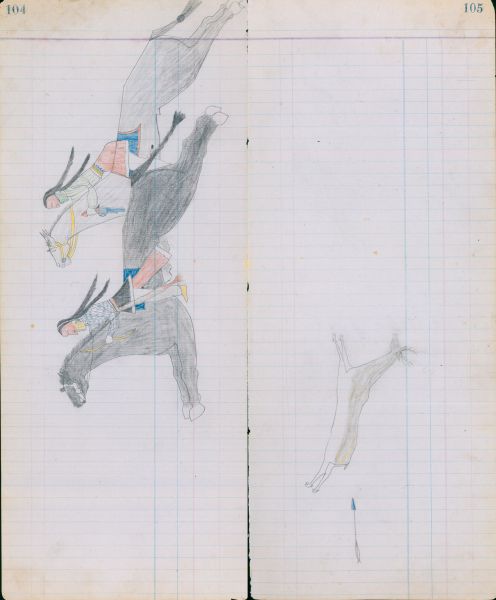PLATE 104-105
Ethnographic Notes
"Deer were usually shot with arrows, something that was not difficult, since in old times they were very numerous, seldom frightened, easily approached, and the arrow made no noise. We may presume that the animal shot at, if wounded, did not connect the hurt with the hunter, even if it saw him" (Grinnell, 1923, I: 276).
The small tail and dark back identify this as a mule deer, what the Cheyennes call a black-tailed deer, Moktaevaseva vaozeva (Petter, 1915: 351). Compare Plate 168, where a different artist depicts the same type of animal. In both cases, as Grinnell was told, arrows rather than firearms are shown as the weapons of choice.
Arrow is riding the lead horse, which has his tiny, protective feather tied to its tail. The same animal appears again in Plates 124, 138 & 140. The companion, who is Arrow's Nisson relative depicted so often before, rides a fork-earred grey horse that will reappear in Plates 134 & 136. The tail of Arrow's black mount has been braided, while the tail of the grey has been tied in an overhand knot---both preparations indicating that the men had expected hard riding through trees, or brushy country. One unusual detail is that Arrow has employed his silver-mounted headstall---an embellishment usually omitted when hunting.
Both riders employ a simple blanket pad as a seat. The shape of the one used by Arrow's comrade, as well as its blue color and red border, suggest that it may be a captured U.S. Army shabrack, or saddle cloth, of the Artillery Corps---compare Woodhead, 1996: 220.
Both men are bare-legged, another indication that they had been prepared for hard, hot riding. On the Plains, however, the weather can change in a heartbeat, so each man also has a blanket wrapped around his waist. Arrow's blanket is secured with a red and green yarn sash which will recur in Plate 106. He wears a standard, long-tailed Cheyenne breechcloth of red wool. Strangely, his comrade does not. This probably is the same man shown in Plate 79, where a breechcloth also is omitted. His blanket here is secured with a cartridge belt for the unused pistol in his left hand.
The similarity of their painted facial designs suggests the close relationship of these two men. Arrow also employs a red upper half in Plates 70, 148, 156 & 160; while the comrade does so again in Plate 79. Interestingly, all of these occasions depict hunting scenes, except Plate 148, which shows Arrow engaged in courting---another kind of hunting.
Both men wear their hair unbound, an unusual circumstance repeated only in Plates 7, 15, 134, 136 and on the rear endpaper. As in the preceding Plate, Arrow wears silver ball-and-cone earrings, here drawn with especial care. The white stripe through his hair represents a scalp ornament, probably brass beads strung on a leather thong. Note that Arrow wears a cloth shirt of commercial manufacture, with a buttoned collar and turned-up lapels. The lack of these details on the other man's shirt probably signals that his garment was hand made by a female relative.


